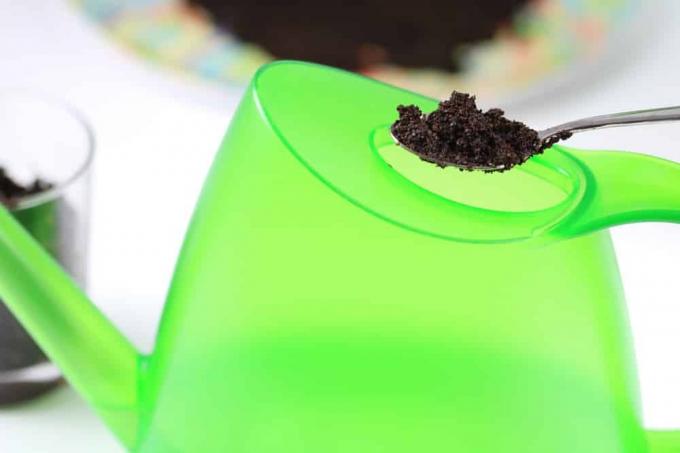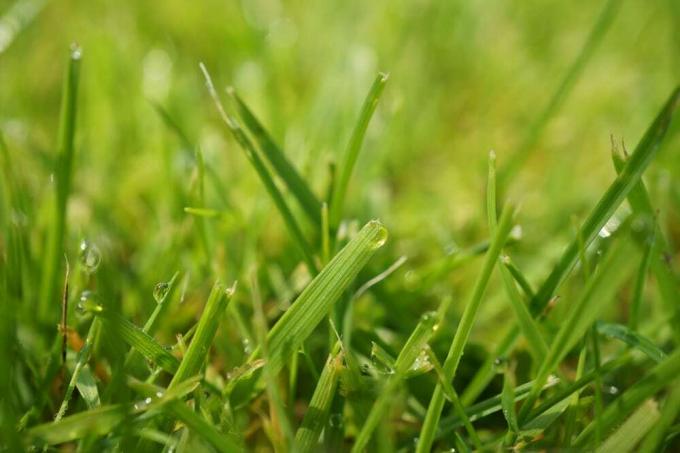

Table of contents
- Innovative combination preparation solves circular reference
- Effective prevention in the service of nature
- Professional mowing
- Balanced fertilizing
- Control weeds and moss
- scarify
- Lime against moss
- Control weeds manually
- Conclusion
An even, lush green lawn is always the result of a holistic care program based on a balanced supply of nutrients. All too often, stubborn weeds and moss throw a spanner in the works for the aspiring hobby gardener. Read here how you can still achieve the goal of an even lawn with the help of combination preparations as lawn fertilizers with weed killers and moss killers. Practical tips for effective prevention against stubborn dandelion, penetrating speedwell, unsightly moss thatch and other adversities pave the way to a perfect lawn, as if by hand woven.
Innovative combination preparation solves circular reference
In the search for a lawn fertilizer that destroys weeds and moss at the same time, hobby gardeners have so far looked in vain. The reason for the manufacturers' reluctance lies in the fact that weeds prefer a Attacks soil with a slightly alkaline pH, while moss is attracted by an acidic pH becomes. The entire plan for combating weeds and moss in the lawn is based on regulating the acidity of the soil. A well-known manufacturer of numerous tried-and-tested products for garden and lawn care succeeded in breaking up this circular relationship. The first combination preparation is available on the market under the name Compo Floranid lawn fertilizer against weeds and moss 4 in 1. In view of the short time available, there has so far been a lack of well-founded empirical values as to the extent to which the problem is actually solved. At least the concept is convincing.
Composition:
- Lawn fertilizer with NK (MgO) formula 14+6+3 with a long-term effect of 3 months
- 1.6 g per kg of dicamba as a herbicide against dicot weeds
- 3.6 g per kg of 2,4-dichlorophenoxyacetic acid as a special herbicide against common lawn weeds
- ferrous sulphate to combat moss
The preparation is administered once a year between May and August at a dosage of 30 g per square meter. The high-priced product costs a whopping 55 euros for a 300 square meter lawn in order to enjoy an even lawn for 3 months. However, the agent is less suitable as an autumn fertilizer due to the relatively low proportion of potassium.
Effective prevention in the service of nature
Looking at the composition of the combination preparation, it becomes clear that the manufacturer is digging deep into the chemical box of tricks. The mineral lawn fertilizer is spiced up with 3 supplements that make conservationists throw their hands up in horror. For example, 2,4-dichlorophenoxyacetic acid was already used as a defoliant in the Vietnam War and is still one of the most common weed killers worldwide after glyphosate and atrazine. The same applies to dicamba, which is usually combined with 2.4-D. As if that were not enough, any moss that has been destroyed using ferrous sulfate is classified as hazardous waste. If you prefer not to treat your lawn with this concentrated load of chemicals, proceed with the following care program. The slightly higher effort is rewarded with a healthy lawn, which vehemently defies weeds and moss, as well as the good conscience of a sparkling clean personal environmental balance.
Professional mowing
The more regularly you mow the lawn, the more the blades of grass get used to the optimal cutting line. The result is a robust grain density that results in excellent photosynthesis capacity. Such a green space easily copes with stress of any kind. The one-third rule has proven itself as a rule of thumb for the ideal cutting height. This states that a maximum of one third of the stalk height is cut per mowing pass. The frequency depends on the type of grass cultivated, the location and the seed mixture used. The following guidelines may serve as a guide:
- High quality ornamental lawn: Mow every 7 days
- Sports and play lawn: Twice a week in summer
- Shade lawn: Cut every 10-12 days
After the first cut of the year leaves the grass still 80 to 100 mm high, it levels off over the course of the summer season, the ideal blade height is 35-45 mm for ornamental and sports lawns and 70-75 mm for shadow lawn. In periods of drought, let the noble grasses stand 10-15 mm higher for a better moisture balance.
Tip:
A green area to be mowed should not be walked on beforehand. Weeds and moss that have been trampled down only rise up again after the mowing cycle, so that they continue to shoot upwards. Of course, consistent mowing weakens seed and spore weeds to such an extent that they retreat.
Balanced fertilizing
In order for your lawn to be ready for competition from weeds and moss, it must not be lacking in nutrients. So that the noble grasses do not suffer from deficiency symptoms, fertilize as follows:
- Give the lawn grass a head start in spring with short-term acting calcium ammonium nitrate
- Apply a mineral-organic long-term fertilizer in April/May with an effect of 3 months
- In July/August, apply an autumn fertilizer with a high concentration of potassium or patent potash
Alternatively, purely organic lawn fertilizers from specialist retailers can be considered for a garden that is managed in a way that is close to nature. You can fertilize your green space in March, May, August and October with finely sieved compost, horn shavings and plant manure. It should be remembered that organic fertilizers must first be processed by the soil organisms in such a way that the nutrients are available to the lawn grasses. If your green business card is already besieged by weeds and moss, a combination of mineral and organic fertilizer in focus, such as a fast-acting nitrogen fertilizer (KAS) and the subsequent organic lawn fertilization. The burst growth suppresses weeds and moss early and effectively until the natural nutrients are available to the grasses.
Control weeds and moss
Although a well-considered care program makes life difficult for weeds and moss, dandelion, speedwell, horsetail, clover and moss still spread from time to time. The earlier you counteract an infestation, the quicker you can get rid of the plague again. The following tips provide best practices:
scarify
When the temperatures are well above 10 degrees Celsius in spring, the best time has come to comb out weeds and moss. Scarifiers can be rented for a day at a garden center or hardware store at a reasonable price. With rotating blades, the device removes any unwanted felt from the turf. Choose a dry, overcast day in March/April to do these steps.
- Mow the lawn as low as possible
- Treat the green area with the scarifier in a checkerboard pattern
- Rake up the combed plant material and dispose of it in the compost
After a regeneration of 8-14 days, apply the selected lawn fertilizer. In the following days, the green is repeatedly and extensively watered.
Lime against moss
If moss dominates in the lawn, this dilemma indicates that the pH value is too low. If a test kit from the garden center confirms the suspicion, you cannot get rid of the lawn thatch with scarifying and fertilizing alone. By regulating the soil acid value with lime, you permanently deprive the moss of its basis of life. After combing out and before applying lawn fertilizer, the green area is therefore whitewashed. The determined pH value and the soil conditions define the exact dose. After the lime has been applied with the spreader, sprinkle the lawn extensively. We recommend a waiting period of 3-4 weeks before using the lawn fertilizer so that the preparations do not interfere with each other's effectiveness.
Control weeds manually
If you resist the beginnings, you can save yourself the use of chemical weed killers in the lawn. Regular mowing leaches seed weeds out over time. In order to put a stop to other weeds, we have put together the following tips for you:
- Pull out individual root weeds with the weed puller or by hand
- Fight dandelions with repeated sprinkling of pure charcoal ash
- Douse deep-reaching root weeds with boiling water, pluck them out and close the gap with lawn seed
- Cut off thistles just before watering the lawn to allow rain into the hollow stems, causing them to rot
- Close gaps in the lawn after the scarifier with turbo reseeding before weeds and moss do
Weedy patches of lawn can be cut off and lifted out with a spade. Lawn pavers and rolled turf segments are available in specialist shops to close the gaps with vital noble grasses within a short time.
Tip:
Don't worry about a hopelessly weedy and moss-covered lawn for an unnecessarily long time. With the help of the rolled turf sandwich method, you can transform the battered green area into a fresh green carpet within a day. At the same time, this saves the high cost of a completely new system.
Conclusion
An even lawn carpet is not given to anyone, but needs to be actively worked out with a well-balanced care program. If, despite all efforts, the green area becomes disfigured by penetrating weeds and moss matting, lawn fertilizer with weed killer and moss killer provide a temporary remedy. In order to get rid of the problem in the long term, or rather not to be confronted with it in the first place, a sophisticated package of preventive measures is required. Professional mowing is just as important as annual scarifying, well-dosed mineral or organic fertilizers and liming. In the early stages of infestation, manual control methods stop weeds and moss so effectively that resorting to expensive chemical preparations takes a back seat.
 garden editorial
garden editorial I write about everything that interests me in my garden.
Learn more about fertilizer

Lawn lime: Lime against moss in the lawn
As soon as moss appears in the lawn, many a hobby gardener becomes restless - because soon the moss carpet can take over entire areas. With lawn lime, however, the unwelcome visitor can be skilfully put in his place.

Build your own Bokashi bucket | DIY instructions
Most of the kitchen waste goes on the compost or in the organic bin to add it back to nature's cycle. But there is a way to gain valuable fertilizer beforehand. We show how easy it is to build a Bokashi bucket and use it to obtain liquid fertilizer on the balcony or even in the apartment.

These 8 plants don't like coffee grounds as fertilizer
Hobby gardeners swear by the effect of the coffee grounds. It is fertilizer, snail protection, soil conditioner and cat deterrent all at the same time. In addition, it is free of charge and occurs daily in the household. Most plants are strengthened, but some are sensitive to the addition of coffee. We clarify.

Fertilize Christmas roses properly: 11 effective home remedies
Christmas roses are special flowers because, unlike almost all other perennials, they bloom in winter. They are insensitive and frost-hardy, and they can also multiply independently. Here you can find out what needs to be considered when fertilizing.

Lawn Bokashi: 6 steps to a cheap & natural fertilizer
The name Bokashi is still largely unknown. This method of using grass clippings comes from Japan. With a little preparation and a special form of processing, the clippings become valuable, nutrient-rich fertilizer that can be easily distributed in the garden.

Wood ash as fertilizer | These 70 plants love barbecue and charcoal
Home gardeners with a fireplace or tiled stove receive a natural fertilizer for free. Charcoal and charcoal leave behind a dusty residue that is packed with valuable nutrients. Read here under what conditions wood ash is suitable as a fertilizer. These 70 plants benefit from the unorthodox nutrient supply.



